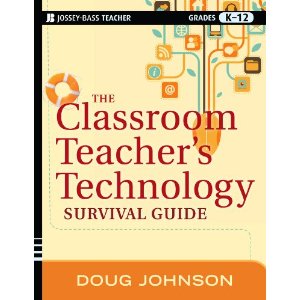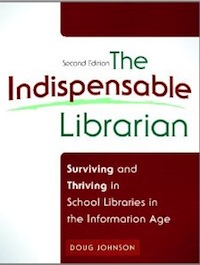10 ways to encourage creativity in your library
10 ways to encourage creativity in your library
HFE October, 2012
Doug Johnson
doug0077@gmail.com
My fifth grade grandson Paul was ready with his report on Vasco da Gama. He had a costume. He had props. He had a story to tell. He was ready to dramatize a pretty dull subject and make it fun for his classmates - and for himself.
And then his teacher announced that she did not allow props, costumes or narrative reporting. Thud. Good thing his grandfather lives seven hours away. We just might have had an impromptu (grand)parent/teacher conference.
Thankfully, most teachers, parents, and organizations recognize the growing need for today’s successful people to be creative. (See my article “Developing Creativity in Every Learner” in this issue.) But creativity doesn’t just happen. It needs to be cultivated. Here are a few everyday things librarians can do to make their programs ones that encourage creative behaviors in kids - and maybe even teachers.
- Ban clip art - in all assignments. I know, I know, clip art is quick, easy, and readily available in many programs. But don’t let kids use it. They should be creating their own visuals for their projects. Scanned original drawings, illustrations created with graphics programs, and student-taken photographs are all ready sources of visual information we haven’t seen dozens of times. Let’s put those cameras, KidPix, and scanners to positive use.
- Ask for information to be shared in at least two media formats. Even if the primary requirement of an assignment is a piece of writing, we should be asking that the same information be conveyed as a graphic, an audio-recording, a drama, a cartoon, or a poster. Using multiple media requires the learner to think about the contents in two different ways and encourages new approaches to delivering a message.
- Encourage the narrative voice in writing and oral presentations. Good assignments help teach not just content, but learning processes as well. Ask students not just to tell the answer to a research question, but to tell the story about how they found the information, what challenges they faced, and what new tricks they acquired. Make research a journey, not just a destination, and ask students to tell that story - emphasizing creative problem-solving strategies.
- Ask for multiple possible answers to questions or multiple possible solutions to problems. Most adults who read the paper, have political opinions, or have encountered puzzling events, recognize there is rarely if ever a single viewpoint on an issue or just one solution to a problem. By asking kids for two or three “right” answers, not only do they need to be more creative, but perhaps more empathetic as well.
- Give points for “design” on all assignments. OK, neatness counts. It always did and always will. But today’s effective communicator needs to know some design skills as well. Oh, you say you don’t have them yourself? Read Robin Williams’s wonderful little book The Non-Designer’s Design Book (Peachpit Press, 2008) In it she demonstrates four simple design rules that everyone can master. - proximity, alignment, repetition and contrast. You own materials will never look so good - and you can pass your secrets on to you students.
- Instead of simply telling a student his or her response is “wrong,” ask for a reason why the answer was given. In one of my favorite children’s books, Miriam Cohen’s First Grade Takes a Test (Star Bright Books, 2006), poor George when answering a standardized test question about what rabbits eat, had to draw in a carrot since he assumed the test creators did not know the “right” answer. By asking students why they gave the answer they did, misunderstandings can certainly be cleared-up, but often a refreshingly new approach to a problem emerges.
- Take advantage of free online tools that encourage creativity. I’ve long sensed that kids like technology because its use in schools is too often the only chance they get to be creative. Even if it just selecting the background of slide show or the font of a paper, kids at least get some choices. Online tools have opened the door to not just allowing, but encouraging creativity. Simple programs like Big Huge Lab’s “Motivator,” Animoto, and Wordle don’t require artistic “ability,” just a little imagination to make some very cool visuals.
- Ask students to help formulate classroom rules, modify procedures, and solve issues. Students can and should demonstrate their creativity in areas other than the arts. Are you having a problem writing a library policy that everyone can buy into? Turn the problem over to your primary library users for their creative solutions. Is there conflict or tension in a class? I’ll bet you’ve got kids who have creative interpersonal skills who can suggest a new approach. Try it and see what happens.
- Honor students’ personal interests and unique talents when teaching skills. In order for students to think hard, think broadly, and think creatively about a subject, they must have enough interest in that subject to care about it. Combining a personal interest with a mandated research topic can lead to creativity. Required content + personal interest = success and originality.
- Seek out the creative ideas of other educators. Keep your eyes open for innovative and effective projects and practices of other librarians and teachers. Use other’s creative approaches and make them your own. It’s not just music that can be remixed





Reader Comments